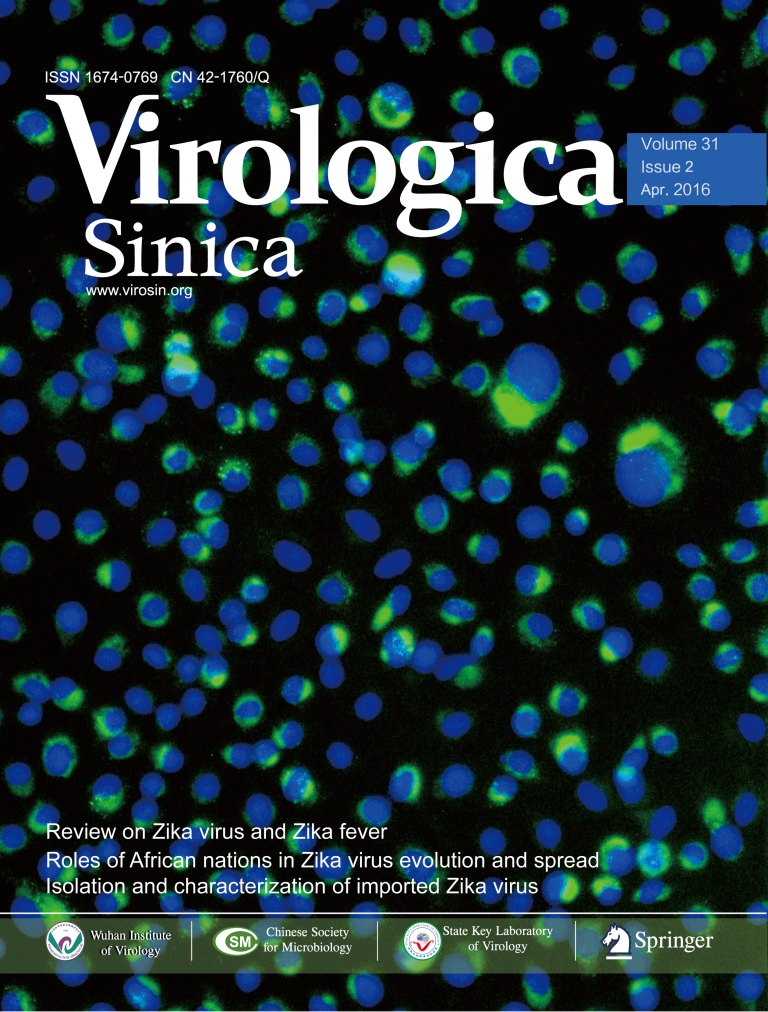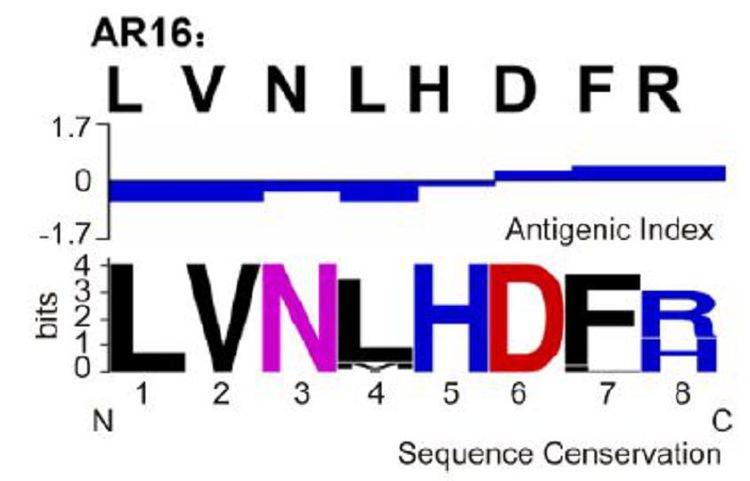-
Bachmann MF, Jennings GT. 2010. Vaccine delivery: a matter of size, geometry, kinetics and molecular patterns. Nat Rev Immunol, 10: 787-796.
doi: 10.1038/nri2868
-
Bolhassani A, Rafati S. 2008. Heat-shock proteins as powerful weapons in vaccine development. Expert Rev Vaccines, 7: 1185-1199.
doi: 10.1586/14760584.7.8.1185
-
Cai K, Feng JN, Wang Q, Li T, Shi J, Hou XJ, Gao X, Liu H, Tu W, Xiao L, Wang H. 2010. Fine mapping and interaction analysis of a linear rabies virus neutralizing epitope. Microbes Infect, 12: 948-955.
doi: 10.1016/j.micinf.2010.06.005
-
Chen C, Li J, Bi Y, Jia X, Meng S, Sun L, Liu W. 2012. Gp96 enhances the immunogenicity of subunit vaccine of porcine reproductive and respiratory syndrome virus. Virus Res, 167: 162-172.
doi: 10.1016/j.virusres.2012.04.011
-
Cliquet F, Aubert M, Sagne L. 1998. Development of a fluorescent antibody virus neutralisation test (FAVN test) for the quantitation of rabies-neutralising antibody. J Immunol Methods, 212: 79-87.
doi: 10.1016/S0022-1759(97)00212-3
-
Commission of Chinese Veterinary Pharmacopoeia. 2010. Veterinary Pharmacopoeia of the People's Republic of China. Chemical Industry Press: 163-168.
-
Crooks GE, Hon G, Chandonia JM, Brenner SE. 2004. WebLogo: a sequence logo generator. Genome Res, 14: 1188-1190.
doi: 10.1101/gr.849004
-
Degen WG, Jansen T, Schijns VE. 2003. Vaccine adjuvant technology: from mechanistic concepts to practical applications. Expert Rev Vaccines, 2: 327-335.
doi: 10.1586/14760584.2.2.327
-
Dey AK, Srivastava IK. 2011. Novel adjuvants and delivery systems for enhancing immune responses induced by immunogens. Expert Rev Vaccines, 10: 227-251.
doi: 10.1586/erv.10.142
-
Dietzschold B, Gore M, Marchadier D, Niu HS, Bunschoten HM, Otvos L, Jr., Wunner WH, Ertl HC, Osterhaus AD, Koprowski H. 1990. Structural and immunological characterization of a linear virus-neutralizing epitope of the rabies virus glycoprotein and its possible use in a synthetic vaccine. J Virol, 64: 3804-3809.
-
Dietzschold B, Li J, Faber M, Schnell M. 2008. Concepts in the pathogenesis of rabies. Future Virol, 3: 481-490.
doi: 10.2217/17460794.3.5.481
-
Guy B. 2007. The perfect mix: recent progress in adjuvant research. Nat Rev Microbiol, 5: 505-517.
-
Houimel M, Dellagi K. 2009. Peptide mimotopes of rabies virus glycoprotein with immunogenic activity. Vaccine, 27: 4648-4655.
doi: 10.1016/j.vaccine.2009.05.055
-
Kaur M, Garg R, Singh S, Bhatnagar R. 2015. Rabies vaccines: where do we stand, where are we heading? Expert Rev Vaccines, 14: 369-381.
doi: 10.1586/14760584.2015.973403
-
Koraka P, Bosch BJ, Cox M, Chubet R, Amerongen G, Lovgren-Bengtsson K, Martina BE, Roose J, Rottier PJ, Osterhaus AD. 2014. A recombinant rabies vaccine expressing the trimeric form of the glycoprotein confers enhanced immunogenicity and protection in outbred mice. Vaccine, 32: 4644-4650.
doi: 10.1016/j.vaccine.2014.06.058
-
Kundi M. 2007. New hepatitis B vaccine formulated with an improved adjuvant system. Expert Rev Vaccines, 6: 133-140.
doi: 10.1586/14760584.6.2.133
-
Li H, Nookala S, Re F. 2007. Aluminum Hydroxide Adjuvants Activate Caspase-1 and Induce IL-1 and IL-18 Release. J Immunol, 178: 5271-5276.
doi: 10.4049/jimmunol.178.8.5271
-
Li Y, Song H, Li J, Wang Y, Yan X, Zhao B, Zhang X, Wang S, Chen L, Qiu B, Meng S. 2011. Hansenula polymorpha expressed heat shock protein gp96 exerts potent T cell activation activity as an adjuvant. J Biotechnol, 151: 343-349.
doi: 10.1016/j.jbiotec.2010.12.006
-
Liu X, Yang Y, Sun Z, Chen J, Ai J, Dun C, Fu ZF, Niu X, Guo X. 2014. A recombinant rabies virus encoding two copies of the glycoprotein gene confers protection in dogs against a virulent challenge. PLoS One, 9: e87105.
doi: 10.1371/journal.pone.0087105
-
Mansfield KL, Johnson N, Fooks AR. 2004. Identification of a conserved linear epitope at the N terminus of the rabies virus glycoprotein. J Gen Virol, 85: 3279-3283.
doi: 10.1099/vir.0.80362-0
-
Marissen WE, Kramer RA, Rice A, Weldon WC, Niezgoda M, Faber M, Slootstra JW, Meloen RH, Clijsters-van der Horst M, Visser TJ, Jongeneelen M, Thijsse S, Throsby M, de Kruif J, Rupprecht CE, Dietzschold B, Goudsmit J, Bakker AB. 2005. Novel rabies virus-neutralizing epitope recognized by human monoclonal antibody: fine mapping and escape mutant analysis. J Virol, 79: 4672-4678.
doi: 10.1128/JVI.79.8.4672-4678.2005
-
McCluskie MJ, Weeratna RD. 2001. Novel adjuvant systems. Curr Drug Targets Infect Disord, 1: 263-271.
doi: 10.2174/1568005014605991
-
Meloen RH, Langeveld JP, Schaaper WM, Slootstra JW. 2001. Synthetic peptide vaccines: unexpected fulfillment of discarded hope? Biologicals, 29: 233-236.
doi: 10.1006/biol.2001.0298
-
Ni Y, Tominaga Y, Honda Y, Morimoto K, Sakamoto S, Kawai A. 1995. Mapping and characterization of a sequential epitope on the rabies virus glycoprotein which is recognized by a neutralizing monoclonal antibody, RG719. Microbiol Immunol, 39: 693-702.
doi: 10.1111/mim.1995.39.issue-9
-
Niederhauser S, Bruegger D, Zahno ML, Vogt HR, Peterhans E, Zanoni R, Bertoni G. 2008. A synthetic peptide encompassing the G5 antigenic region of the rabies virus induces high avidity but poorly neutralizing antibody in immunized animals. Vaccine, 26: 6749-6753.
doi: 10.1016/j.vaccine.2008.10.020
-
Pulmanausahakul R, Li J, Schnell MJ, Dietzschold B. 2008. The glycoprotein and the matrix protein of rabies virus affect pathogenicity by regulating viral replication and facilitating cell-to-cell spread. J Virol, 82: 2330-2338.
doi: 10.1128/JVI.02327-07
-
Rupprecht CE, Gibbons RV. 2004. Clinical practice. Prophylaxis against rabies. N Engl J Med, 351: 2626-2635.
-
Takayama-Ito M, Inoue K, Shoji Y, Inoue S, Iijima T, Sakai T, Kurane I, Morimoto K. 2006. A highly attenuated rabies virus HEP-Flury strain reverts to virulent by single amino acid substitution to arginine at position 333 in glycoprotein. Virus Res, 119: 208-215.
doi: 10.1016/j.virusres.2006.01.014
-
Tao X, Han N, Guo Z, Tang Q, Rayner S, Liang G. 2013. Molecular characterization of China human rabies vaccine strains. Virol Sin, 28: 116-123.
doi: 10.1007/s12250-013-3314-9
-
Villarreal-Ramos B. 2009. Towards improved understanding of protective mechanisms induced by the BCG vaccine. Expert Rev Vaccines, 8: 1531-1534.
doi: 10.1586/erv.09.109
-
Wang S, Qiu L, Liu G, Li Y, Zhang X, Jin W, Gao GF, Kong X, Meng S. 2011. Heat shock protein gp96 enhances humoral and T cell responses, decreases Treg frequency and potentiates the anti-HBV activity in BALB/c and transgenic mice. Vaccine, 29: 6342-6351.
doi: 10.1016/j.vaccine.2011.05.008
-
World Organisation for Animal Health. 2013. Manual of Diagnostic Tests and Vaccines for Terrestrial Animals. OIE Terrestrial Manual: Chapter 2. 1. 13.
-
Xiao XX, Zhang Y, Liu JX, Wei QL, Yin XP. 2015. Immunoenhancement with flagellin as an adjuvant to whole-killed rabies vaccine in mice. Arch Virol, 161: 685-691.
-
Xue XH, Zheng XX, Wang HL, Ma JZ, Li L, Gai WW, Wang TC, Yang ST, Xia XZ. 2014. An inactivated recombinant rabies CVS-11 virus expressing two copies of the glycoprotein elicits a higher level of neutralizing antibodies and provides better protection in mice. Virus Genes, 48: 411-420.
doi: 10.1007/s11262-014-1049-9
-
Yang L, Cen J, Xue Q, Li J, Bi Y, Sun L, Liu W. 2013. Identification of rabies virus mimotopes screened from a phage display peptidelibrary with purified dog anti-rabies virus serum IgG. Virus Res, 174: 47-51.
doi: 10.1016/j.virusres.2013.02.013
-
Yuan Z, Zhang S, Liu Y, Zhang F, Fooks AR, Li Q, Hu R. 2008. A recombinant pseudorabies virus expressing rabies virus glycoprotein: safety and immunogenicity in dogs. Vaccine, 26: 1314-1321.
doi: 10.1016/j.vaccine.2007.12.050
-
Zhang Y, Zhang S, Li W, Hu Y, Zhao J, Liu F, Lin H, Liu Y, Wang L, Xu S, Hu R, Shao H, Li L. 2016. A novel rabies vaccine based-on toll-like receptor 3 (TLR3) agonist PIKA adjuvant exhibiting excellent safety and efficacy in animal studies. Virology, 489: 165-172.
doi: 10.1016/j.virol.2015.10.029












